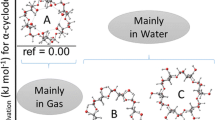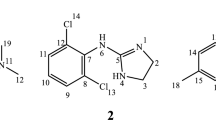Abstract
Solution calorimetry has been employed to evaluate the stability constants and enthalpy changes associated with complex formation between α-, β, or -γ-cyclodextrin (CD) and a group of amine compounds having the diphenylmethyl functionality. Data from thermal titrations of the compounds were analyzed using nonlinear least squares. The standard free energy decrease accompanying the formation of inclusion complexes is generally due to a negative standard enthalpy change (ΔH°). The standard entropy change (ΔS°) was negative, except in the case of complexes formed with γ-CD. Of the 13 compounds studied, only 2 formed complexes with 1:2 (compound: (β-CD) stoichiometry, terfenadine · HC1 and cinnarizine · 2HC1. All the others formed 1:1 complexes. The structural effect on the stability constants, thermodynamics, and inclusion geometry was explored by relating the calorimetric results to the chemical structures of the guest molecules and the cavity sizes of the CD molecules. The results suggest that one of the phenyl groups of the diphenylmethyl functionality resides in the CD cavity and is in van der Waals contact with the inside wall of the CD cavity. In the case of α- and β-CDs, van der Waals interaction dominates in the stabilization. On the other hand, the interaction between these compounds and γ-CD is largely entropically driven. Adiphenine · HC1 forms a more stable complex with β-CD than proadifen · HC1, suggesting that hydrogen bonding to the carbonyl oxygen by the hydroxyl group on the rim of the CD ring can influence the strength of the binding interaction.
Similar content being viewed by others
REFERENCES
J. Szejtli. Inclusion Compounds and Their Complexes, Akademiai Kiadó, Budapest, (1982).
J. L. Lach and W. A. Pauli. Interaction of pharmaceuticals with Schardinger dextrins VI. Interactions of β-cyclodextrin, sodium deoxycholate, and deoxycholic acid with amines and pharmaceutical agents. J. Pharm. Sci. 55:32–38, (1966).
K. Uekama and M. Otagiri. Cyclodextrins in drug carrier systems. Crit. Rev. Ther. Drug Carrier Syst. 3:1–40 (1987)
D. Duchêne, C. Vaution, and F. Glomot. Cyclodextrins, their value in pharmaceutical technology. Drug Dev. Ind. Pharm. 12:2193–2216 (1986).
T. Nagai. Developments in cyclodextrin applications in drug formulations. J. Incl. Phenom. 5:29–38 (1987).
I. Tabushi, Y.-i. Kiyosuke, T. Sugimoto, and K. Yamamura. Approach to the aspects of driving force of inclusion by α-cyclodextrin. J. Am. Chem. Soc. 100:916–919 (1978).
R. J. Clarke, J. H. Coates, and S. F. Lincoln. Inclusion complexes of the cyclomalto-oligosaccharides (cyclodextrins). In Advances in Carbohydrate Chemistry and Biochemistry, R. S. Tipson and D. Horton (eds.), Academic Press, San Diego, 1988, pp. 205–333).
T. Tokumura, H. Ueda, Y. Tsushima, M. Kasai, M. Kayano, I. Amada, and T. Nagai. Inclusion complex of cinnarizine with β-cyclodextrin in aqueous solution and in sold state. J. Incl. Phenom. 2:511–521 (1984).
T. Tokumura, K. Tatsuishi, M. Kayano, Y. Machida, and T. Nagai. Effect of β-cyclodextrin on the degradation rate of cinnarizine in aqueous solution. Chem. Pharm. Bull. 33:2079–2083 (1985).
H. Ueda, J. H. Perrin, and T. Nagai. A microcalorimetric investigation of the binding of cinnarizine to cyclodextrins. J. Pharm. Biomed. Anal. 7:639–642 (1989).
R. A. Winnike. Ionization Properties of the Radiation Protective and Chemoprotective Drug, WR-1065, and Related Aminoalkylthiols, Ph.D. dissertation. University of Iowa, Iowa City, 1989.
M. Kurozumi, N. Nambu, and T. Nagai. Inclusion compounds of non-steroidal antiinflammatory and other slightly water soluble drugs with α-and β-cyclodextrins in powdered form. Chem. Pharm. Bull. 23:3062–3068 (1975).
J. K. Grime (eds.). Analytical Solution Calorimetry, John Wiley & Sons, New York, 1985.
W. C. Cromwell, K. Byström, and M. R. Eftink. Cyclodextrin-adamantanecarboxylate inclusion complexes: Studies of the variation in cavity Size. J. Phys. Chem. 89:326–332 (1985).
D. W. Griffiths and M. L. Bender. Cycloamyloses catalysts. Adv. Catal. 23:209–261 (1973).
SYBYL, Version 5.3, Tripos Assoc. Inc., St. Louis, MO.
Author information
Authors and Affiliations
Rights and permissions
About this article
Cite this article
Tong, WQ., Lach, J.L., Chin, TF. et al. Structural Effects on the Binding of Amine Drugs with the Diphenylmethyl Functionality to Cyclodextrins. I. A Microcalorimetric Study. Pharm Res 8, 951–957 (1991). https://doi.org/10.1023/A:1015880218535
Issue Date:
DOI: https://doi.org/10.1023/A:1015880218535




